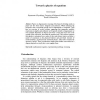AAAI
2000
14 years 1 months ago
2000
This paper demonstrates qualitative spatial reasoning techniques in a real-world diagrammatic reasoning task: Course-of-Action (COA) diagrams. COA diagrams are military planning d...
FOIS
2001
14 years 1 months ago
2001
The uptake in the software industry of notations for designing systems visually has been accelerated with the standardization of the Unified Modeling Language (UML). The formaliza...
AGI
2008
14 years 1 months ago
2008
We give a brief overview of the main characteristics of diagrammatic reasoning, analyze a case of human reasoning in a mastermind game, and explain why hybrid representation system...
DIAGRAMS
2010
Springer
14 years 4 months ago
2010
Springer
Papers on diagrammatic reasoning often begin by dividing marks on paper into two basic classes: diagrams and sentences. While endorsing the perspective that a reasoning episode can...
COSIT
2003
Springer
14 years 5 months ago
2003
Springer
Because diagrams are often created incrementally, a qualitative diagrammatic reasoning system must dynamically manage a potentially large set of spatial interpretations. This pape...
DIAGRAMS
2004
Springer
14 years 5 months ago
2004
Springer
An important aim of diagrammatic reasoning is to make it easier for people to create and understand logical arguments. We have worked on spider diagrams, which visually express log...

